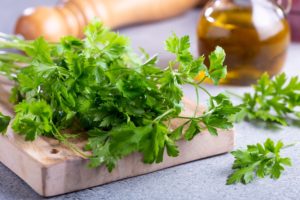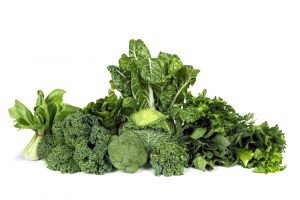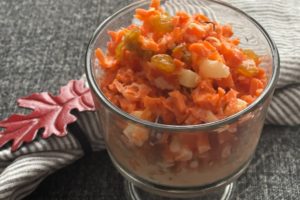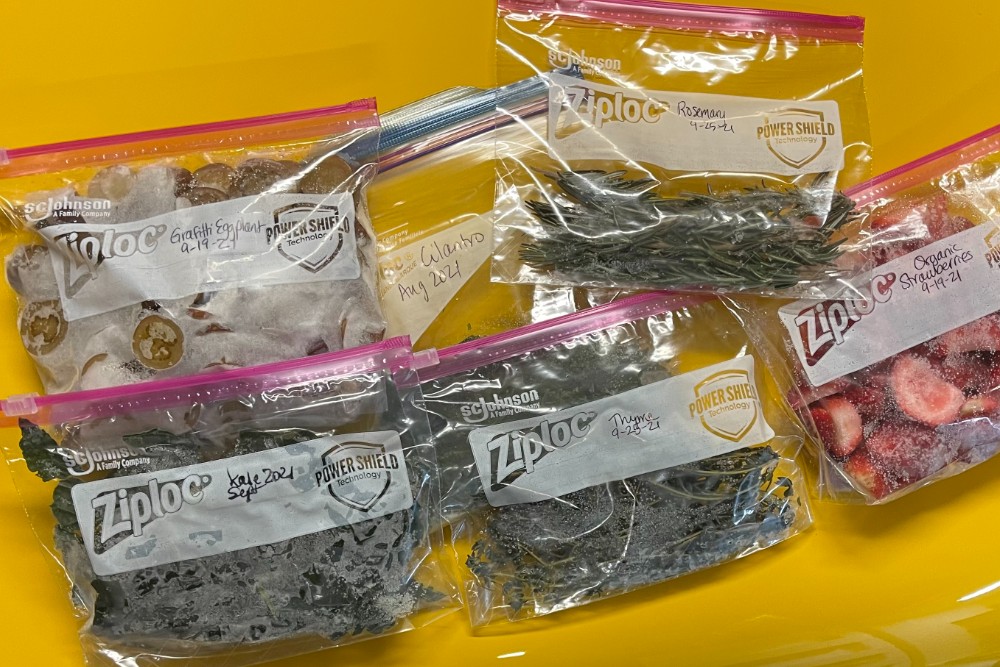What's On This Page?
ToggleFreeze your food, herbs and veggies. Freeze fruit too!
Food shortages are continuing as grocery stores face supply chain issues and fewer deliveries, plus other reasons.
I recently bought a small upright freezer for my garage, but you can certainly use the freezer you have in your home and store plenty of good food for the coming winter season. It’s also a good idea if you live in snowy areas and don’t feel like driving out in a blizzard to get one lemon!
Tips to Minimize Freezer Burn
First, make sure your fruits, vegetables, and spices are as dry as possible. Any humidity present on the leaves will freeze and ruin the integrity of the fruit/vegetable. Second, get all the air out as best you can. I usually use a straw to siphon out all air in the bag as I seal it. Alternatively, you can press and roll the filled-up baggies and most of the air will get pushed out too. There are also machines that will do a great job of this but I don’t have one so I can’t comment on functionality or ease of use.
Here are ideas for what you can freeze, and you should do this because of the tremendous health benefits. You really don’t want to be without the following:
Parsley and Cilantro.
Parsley is known as a blood cleanser and diuretic. It doesn’t matter if it is Italian parsley or Curly Parsley.
Cilantro is known as a heavy metal chelator and anti-diabetic herb. I recommend bagging these two herbs separately but I’ll handle them both here because they are processed the same. Take a bunch and cut off the stems, and wash them well. Spread them out on a clean towel and dry them the best you can.

Try to get as much water off as possible. You can chop them nicely if you want to, but this is optional. Once dry, put them in a little storage bag and seal tightly getting out as much air as you can. Be sure to label your baggie with the herb’s name and the date. Here’s a recipe for Parsley Diuretic Tea.
Yellow Onion.
I love freezing onions because I have an open floor plan in my house, and each time I cut an onion, the whole house wafts of it! So I will buy 5 large onions at a time and spend an afternoon processing them. It’s pretty simple too. Just cut off the ends of the onion, and peel it. Chop the onions in the size that you want to, whether that is sliced, chopped finely or minced. Once complete, put into a storage container that has a very tight seal and freeze it.
Kale.

Kale contains many anti-cancer compounds and sometimes it’s hard to find if it’s out of season. There are many ways to freeze kale, but I think the best way is to take a bunch and cut it into pieces. Then wash it very well. I use FIT Organic Fruit and Vegetable spray to clean virtually all my food. Once the kale is fully washed, just drain it and dry it the best you can with some paper towels. Lay the pieces out on a cookie sheet lined with wax paper.
Freeze that for an hour, then take it out and you’ll be able to take the individual pieces of kale and put them into a storage bag. If you don’t do it this way, you’ll wind up with one big green glob that’s hard to work with! Kale is one of those foods that if eaten raw, can impact your thyroid hormone production. It’s a goitrogen. Read The Case Against Kale.
Carrots.
I cut off the green tops and the very ends of the carrots, then peel them. Give them a quick rinse and then chop them into slices. I blanch them and to do that you just have to simmer the carrots for 3 minutes, then take them off the heat immediately and drop them into a bowl that contains ice water, and leave them there for 3 more minutes. That stops the cooking immediately. Once you are done blanching them, lay them out on a cookie sheet that’s been lined with wax paper.

Dry them off completely. Freeze these sliced, blanched carrots for an hour then take them out and move the slices to some freezer bags that you can seal tightly. Be sure to get the air out. Carrots contain beta carotene which converts to vitamin A in the body, and you need A for good eyesight, beautiful skin, and a strong immune system.

Rosemary and Thyme.
Every rice dish and soup I make contains rosemary and thyme. The former is known to support healthy estrogen metabolism and that’s important for breast health. The thyme has a lot of thymol which is a phenomenal antioxidant. The compounds in both rosemary and thyme exert strong antibacterial, anti-fungal, and anti-inflammatory actions on the body.
Because of the extraordinary health benefits, I recommend you freeze them in case there’s a shortage. You can freeze them two different ways actually.

First, you can rinse them and then remove the leaves off the sprigs and put a tablespoon worth into each cube of an ice cube tray. Then you cover that with some good olive oil and freeze the whole tray. This does not impact the quality of your oil, don’t worry. When ready to use it, just put a cube into your soup and cook with it.
The other way to freeze these herbs is simpler. You rinse and dry them, and then put the whole sprig into a storage bag. Press all the air out of it, seal it, and freeze. Be sure to label the bag.
Want to grow rosemary in your garden? Read the ALMANAC SITE for planting, growing, and harvesting rosemary.
Lemons.
These are so nice to have throughout the year because in the summer, you can put a wedge in some sparkling ice water, and in the winter, you can use lemon for your hot ginger tea. Lemons help with appetite control and provide a lot of vitamin C. I use lemon juice in my marinades, smoothies and teas. Honestly, I never want to be without lemons! Wash the lemons well and slice them or cut them into wedges.
Dry them a little bit and put into your labeled storage bag and freeze. Get as much air out as you can. If you want to freeze lemon peel you absolutely can. Zest it with your tool and put it into a small storage container and freeze. Try this Lemon Dill Sauce.
Strawberries and Blueberries.
Blueberries and other colorful berries have anthocyanins that are extremely helpful for your eyes and blood vessels. For the strawberries, cut off the leafy end and slice them in half, or in quarters if they are large. Wash them well and lay them out on a cookie sheet that has some wax paper on top. Lay them out carefully so that you can put the cookie sheet in your freezer and allow them to freeze individually.
After an hour, they should be solid and that’s when you can put them into a freezer bag. Doing it this way prevents one gigantic strawberry glob that’s stuck together. For blueberries, the process is the same. Try my famous Blueberry Sour Cream Pie.
Tomatoes.
Once a tomato has been frozen, you cannot slice it for a sandwich as you might think. So freezing tomatoes are useful if you like to use them in sauces or marinades or soups. Tomatoes contain lycopene, vitamin C and A, and something called alpha tomatine. Collectively, these constituents make tomatoes one of the most protective fruits you can eat.
Studies have shown that eating tomatoes can help reduce the incidence of all kinds of health problems, even those related to your prostate and your heart. Of all cancers, prostate cancer has been most widely researched when it comes to tomatoes. To freeze a tomato, simply wash a few of them, pat them dry, and place them into a storage bag. Make sure you get all the air out of it.

Suzy Cohen, has been a licensed pharmacist for over 30 years and believes the best approach to chronic illness is a combination of natural medicine and conventional. She founded her own dietary supplement company specializing in custom-formulas, some of which have patents. With a special focus on functional medicine, thyroid health and drug nutrient depletion, Suzy is the author of several related books including Thyroid Healthy, Drug Muggers, Diabetes Without Drugs, and a nationally syndicated column.


